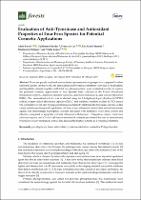Por favor, use este identificador para citar o enlazar este ítem:
https://repositorio.usj.es/handle/123456789/261
Registro completo de metadatos
| Campo DC | Valor | Lengua/Idioma |
|---|---|---|
| dc.contributor.author | Farràs, Adrià | - |
| dc.contributor.author | Cásedas, Guillermo | - |
| dc.contributor.author | Les Parellada, Francisco | - |
| dc.contributor.author | Terrado, Eva María | - |
| dc.contributor.author | López Ramos, Víctor | - |
| dc.date.accessioned | 2019-12-11T13:01:32Z | - |
| dc.date.available | 2019-12-11T13:01:32Z | - |
| dc.date.issued | 2019-02-19 | - |
| dc.identifier.citation | Farràs, A.; Cásedas, G.; Les, F.; Terrado, E.M.; Mitjans, M.; López, V. Evaluation of Anti-Tyrosinase and Antioxidant Properties of Four Fern Species for Potential Cosmetic Applications. Forests 2019, 10, 179. | es_ES |
| dc.identifier.issn | 1999-4907 | es_ES |
| dc.identifier.uri | https://repositorio.usj.es/handle/123456789/261 | - |
| dc.description.abstract | Ferns are poorly explored species from a pharmaceutical perspective compared to other terrestrial plants. In this work, the antioxidant and tyrosinase inhibitory activities of hydrophilic and lipophilic extracts, together with total polyphenol content, were evaluated in order to explore the potential cosmetic applications of four Spanish ferns collected in the Prades Mountains (Polypodium vulgare L., Asplenium adiantum-nigrum L., Asplenium trichomanes L., and Ceterach officinarum Willd). The antioxidant activity was evaluated using the 2,2-diphenyl-1-picrylhydrazyl (DPPH) radical, oxygen radical absorbance capacity (ORAC) and xanthine/xanthine oxidase (X/XO) assays. The potential to avoid skin hyperpigmentation was tested by inhibiting the tyrosinase enzyme, as this causes melanin synthesis in the epidermis. All ferns were confirmed as antioxidant and anti-tyrosinase agents, but interestingly hydrophilic extracts (obtained with methanol) were more potent and effective compared to lipophilic extracts (obtained with hexane). Polypodium vulgare, Asplenium adiantum-nigrum, and Ceterach officinarum methanolic extracts performed the best as antioxidants. Polypodium vulgare methanolic extract also showed the highest activity as a tyrosinase inhibitor. | es_ES |
| dc.format.extent | 14 p. | es_ES |
| dc.format.mimetype | application/pdf | es_ES |
| dc.language.iso | eng | es_ES |
| dc.publisher | MPDI | es_ES |
| dc.relation.requires | Adobe PDF | es_ES |
| dc.rights | Atribución 4.0 Internacional | * |
| dc.rights.uri | http://creativecommons.org/licenses/by/4.0/ | * |
| dc.subject | Pteridophytes | es_ES |
| dc.subject | Ferns | es_ES |
| dc.subject | Antioxidant | es_ES |
| dc.subject | Tyrosinase inhibition | es_ES |
| dc.subject | Cosmetics | es_ES |
| dc.subject | Polypodiopsida | es_ES |
| dc.title | Evaluation of Anti-Tyrosinase and Antioxidant Properties of Four Fern Species for Potential Cosmetic Applications | es_ES |
| dc.type | info:eu-repo/semantics/article | es_ES |
| dc.subject.unesco | Nutrición de las plantas | es_ES |
| dc.relation.publisherversion | https://www.mdpi.com/1999-4907/10/2/179 | es_ES |
| dc.identifier.doi | https://doi.org/10.3390/f10020179 | es_ES |
| dc.rights.accessrights | info:eu-repo/semantics/openAccess | es_ES |
| Aparece en las colecciones: | Artículos de revistas | |
Ficheros en este ítem:
| Fichero | Descripción | Tamaño | Formato | |
|---|---|---|---|---|
| forests-10-00179.pdf | 1,53 MB | Adobe PDF |  Visualizar/Abrir |
Este ítem está sujeto a una licencia Creative Commons Licencia Creative Commons

